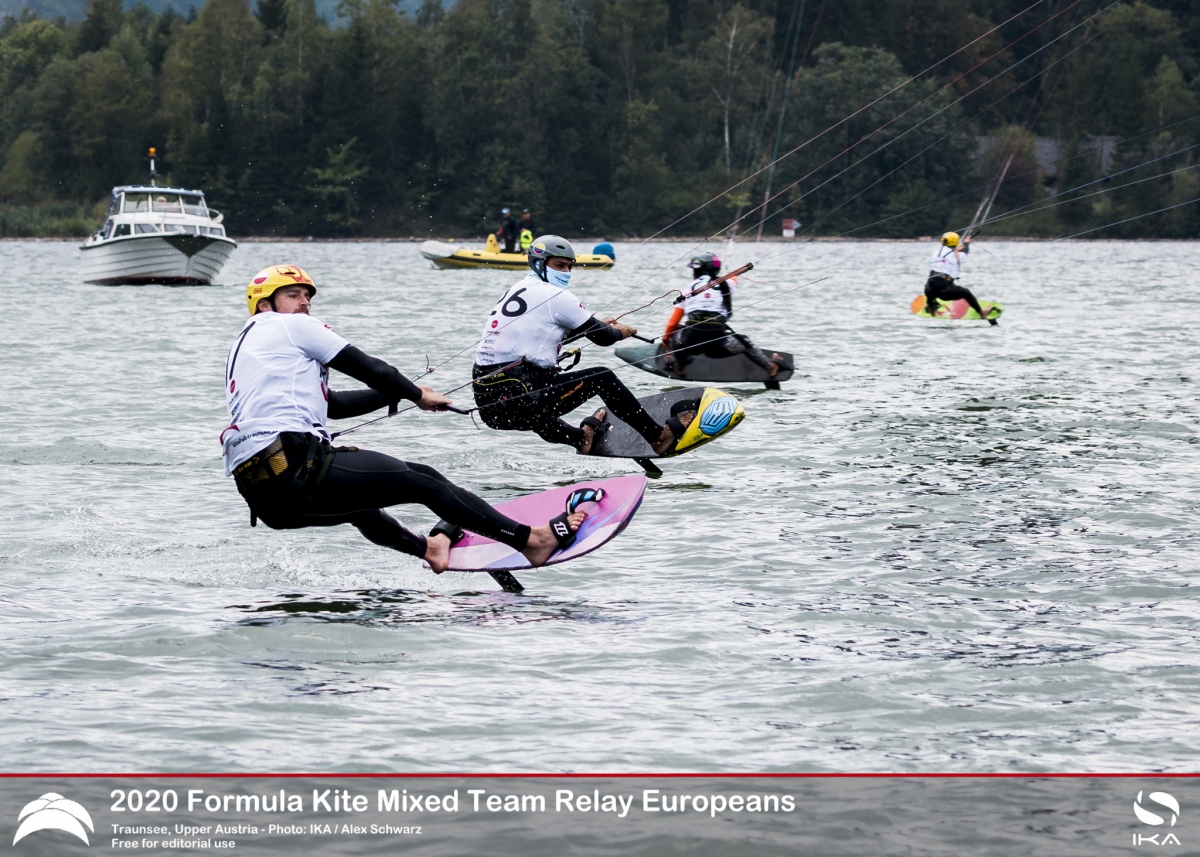With the women starting first, JULIA DAMASIEWICZ (POL) proved why she is currently ranked #1 in the world, dominating her lap of the race. “A lot of training... Maybe it was about a good start but also a bit about the gear,” said JULIA, racing an OZONE R1 V4 19. 
JULIA DAMASIEWICZ carving out a gybe
The new format is proving to be exciting and getting better all the time, with the racing no longer being a “follow the leader” style procession, but with exciting lead changes occurring often. When JULIA crossed the changeover line in 1st, executing an impressive changeover with her teammate JAKUB JURKOWSKI (POL), the pressure was still on.

JAKUB JURKOWSKI in full race mode
“My partner JULIA came first, and all the way to the upwind buoy I was first, and then on the downwind buoy, FLORIAN GRUBER (GER) overtook me and he was first and I was second. He had very good speed and angle downwind... he is riding very good, so it is not just about equipment,” said JAKUB, cheerful at having been so competitive against the older, more experienced GRUBER, who at world #3, is ranked substantially higher than the #23 seed JURKOWSKI.
The wind wavered and dipped below 5 knots, prompting a brief postponement ashore before the AP being removed again at 1355, allowing another race for all fleets to be completed in 6-7 knots. The second round of racing proved quite similar, with plenty of action despite the light winds.
In a fit of deja vu, JULIA, JAKUB and FLORIAN played out a carbon copy of their earlier race of the day, whilst further back in the same race, battling for 4th DENIS TARADIN (RUS) crashed out on the final gybe, trying to overtake BLAZEJ OZOG (POL), although managed to recover enough to secure 5th in that race.
Another brief postponement ashore during a light wind spell, and the riders were sent out again for further qualification races.
The format for the racing developed by the IKA is designed to cater to the medias' desire that the competitor who crosses the finish line in 1st place of the final race, wins the overall event, whilst ensuring that the racing stays fair and avoids a “winner take all” scenario often affected by chance.
Since only one 2024 Olympic medal was available for kiteboarding, the Mixed Team Relay configuration was chosen, deemed more exciting and fair than racing women and men separately and adding the points.
“Since we can not pass a baton like in running, we have used swimming relay as the basis for our format. So when one competitor crosses the ‘changeover line,’ finishing their lap, their teammate begins their lap by crossing the same line simultaneously. The position during the changeover is not counted, but the final position at the finish line determines the placing for the team as a whole, bringing in an element of strategy. In addition, since the riders have closing speeds close to 100km/h, the timing is critical for the changeover, providing some spectacular racing” says MARKUS SCHWENDTNER, IKA Secretary General.
“There has also been a lot of consideration in designing the racing and scoring format, to come up with a fair racing scheme that satisfies the media driven desire for a “first across the line wins overall”.
“To that end, we have the opening series, after which, the two top placed teams overall go straight to the Finals. The subsequent 12 teams then progress to the semi finals, with 6 in each fleet.
“Although the points are reset after qualifying, in order to acknowledge the teams’ performance in opening races, these teams start with the number of points equal to their position as they enter the semi finals.This is done to condense the fleet while rewarding those who performed well during the opening series. Doing away with large point disparities makes the racing close across the 2 races we have in the semi finals."
“This way, all teams who make it to the semi finals, have a chance to make the finals and win the event. Immediately after the semi finals have each completed 2 races using the standard low point system, the winner of each of those fleets then progress to the finals.

The new format is designed to provide fair racing for the competitors and exciting action for the spectators.
“The semi finals and finals all happen on one day, typically called “Super Sunday,” with the idea being that if there are 14 teams racing on the final day, audience interest comes from 14 nations, as opposed to having the finals raced separately where only 4 nations are represented, greatly reducing the media attention.
“The medal series is scored in a different way in order to achieve this “first over the line” concept. We have devised a first-to-three, “match point” system, similar to tennis, where the team that qualified 1st for the finals begins the finals with 2 points, the 2nd placed team starts with 1 point, and the two teams who come from the semi finals start with 0. Since it is first-to-three, the 1st place team need only win the first finals race to win overall, the 2nd place team must win 2 races etc.
“This ensures that the overall winner of the event, is the team that wins the last race, making it more attractive for spectators, while rewarding those teams that did well throughout the whole event. We have used this system a few times with great success, and we are fine tuning the concept as we move forward, listening to feedback from competitors and other participants.”
Although radically different from the double-points medal race format of recent years, this new format has been widely praised by competitors, teams and media alike, and presents the kiteboard racing in an exciting new way that will generate maximum interest for our sport from the general public, securing the future of sailing and riding for years to come.
 FLORIAN GRUBER and LEONIE MEYER sit in 1st after seven qualifying races
FLORIAN GRUBER and LEONIE MEYER sit in 1st after seven qualifying races
After seven qualifying races, FLORIAN GRUBER / LEONIE MEYER (GER) are in first, closely followed by CONNOR BAINBRIDGE / ELLIE ALDRIDGE and GUY BRIDGE / KATIE DABSON (all GBR).
Racing continues with the opening series through to Saturday, and the semi-finals and medal series scheduled for "Super Sunday".
Top 5 teams after 7 races (2 discards)
| 1 | GER 10 | Gruber / Meyer | 5 pts |
| 2 | GBR 14 | Bainbridge / Aldridge | 6 pts |
| 3 | GBR 22 | Bridge / Dabson | 6 pts |
| 4 | POL 21 | Wojciechowski / Woyciechowska | 7 pts |
| 5 | FRA 12 | Nocher / Nolot | 8 pts |
Full results: https://www.formulakite.org/results




